In today’s digital age, the traditional exchange of physical business cards is evolving rapidly. With advancements in technology and the increasing reliance on digital platforms, the concept of digital business cards is gaining traction as a convenient and efficient way to network and establish professional connections. In this article, we’ll delve into what exactly a digital business card is, its benefits, and why it’s becoming an indispensable tool for modern professionals.
Understanding Digital Business Cards

A digital business card, as the name suggests, is a digitalized version of the traditional paper business card. Instead of exchanging physical cards during networking events or meetings, individuals can now share their contact information electronically using digital business card platforms or apps.
These digital cards typically contain essential contact details such as name, job title, company name, phone number, email address, and website. However, what sets them apart is their dynamic nature, allowing users to incorporate multimedia elements such as logos, photos, social media links, and even videos to make a lasting impression.
The Benefits of Going Digital
Enhanced Accessibility: Unlike paper business cards that can easily get lost or misplaced, digital business cards can be stored and accessed conveniently on smartphones, tablets, or computers. This ensures that your contact information is always within reach whenever needed.
Environmentally Friendly: In an era where sustainability is paramount, opting for digital business cards helps reduce paper waste, making it an eco-friendly choice. By embracing digital solutions, professionals can contribute to environmental conservation efforts while still maintaining effective networking practices.
Cost-Effective: Printing traditional business cards can incur significant expenses, especially for frequent networkers or those who frequently update their contact details. Digital business cards eliminate printing costs and allow for easy updates, saving both time and money in the long run.
Dynamic and Interactive: Digital business cards offer opportunities for creativity and personalization. With multimedia capabilities, users can showcase their brand personality, portfolio, or product offerings in a visually engaging manner, leaving a memorable impression on recipients.
Analytics and Insights: Unlike paper cards, digital business card platforms often come with analytics features that provide insights into how recipients interact with your card. This data can include the number of views, clicks on links, and engagement with multimedia content, enabling users to gauge the effectiveness of their networking efforts.
Seamless Integration: Digital business cards can seamlessly integrate with other digital tools and platforms, such as email signatures, LinkedIn profiles, or CRM systems. This integration streamlines the process of exchanging contact information and facilitates smoother follow-ups after initial meetings or interactions.
How to Make and Distribute Electronic Business Cards
Creating a digital business card is simple and straightforward, thanks to various online platforms and mobile apps designed for this purpose.
Here’s a step-by-step guide:
Select a Digital Business Card Platform: Do your homework and find a reliable software or platform that meets your requirements and tastes for your digital business card. Look for features such as customization options, multimedia support, and compatibility with different devices and operating systems.
Create Your Card: Once you’ve chosen a platform, sign up and start creating your digital business card. Input your contact details, including name, job title, company name, phone number, email address, and website. Take advantage of multimedia features to enhance your card with visuals, logos, and relevant links.
Customize and Personalize: Tailor your digital business card to reflect your personal brand or professional identity. Add a professional photo, include links to your social media profiles or portfolio, and incorporate any other relevant information that showcases your expertise or offerings.
Preview and Test: Before sharing your digital business card, take the time to preview and test it on different devices and platforms to ensure optimal display and functionality. Check for any formatting issues or errors that may detract from the card’s effectiveness.
Share Your Card: Once you’re satisfied with your digital business card, it’s time to start sharing it with your network. You can do this by sending it via email, text message, or through dedicated sharing features offered by the platform. Additionally, consider adding it to your email signature, social media profiles, or LinkedIn profile for increased visibility.
Track and Analyze: Monitor the performance of your digital business card using the analytics tools provided by the platform. Pay attention to metrics such as views, clicks, and engagement to assess the effectiveness of your networking efforts and make any necessary adjustments.
Conclusion
In conclusion, digital business cards offer a modern and efficient alternative to traditional paper cards, enabling professionals to network effectively in today’s digital landscape. With their accessibility, sustainability, and versatility, digital business cards have become indispensable tools for building and nurturing professional connections. By embracing digital solutions and leveraging multimedia capabilities, individuals can make a lasting impression and stay ahead in the competitive world of modern networking.
Whether you’re a seasoned professional, an entrepreneur, or a recent graduate entering the workforce, incorporating digital business cards into your networking strategy can open doors to new opportunities and connections. Embrace the future of networking with digital business cards and unlock your potential in the digital age.